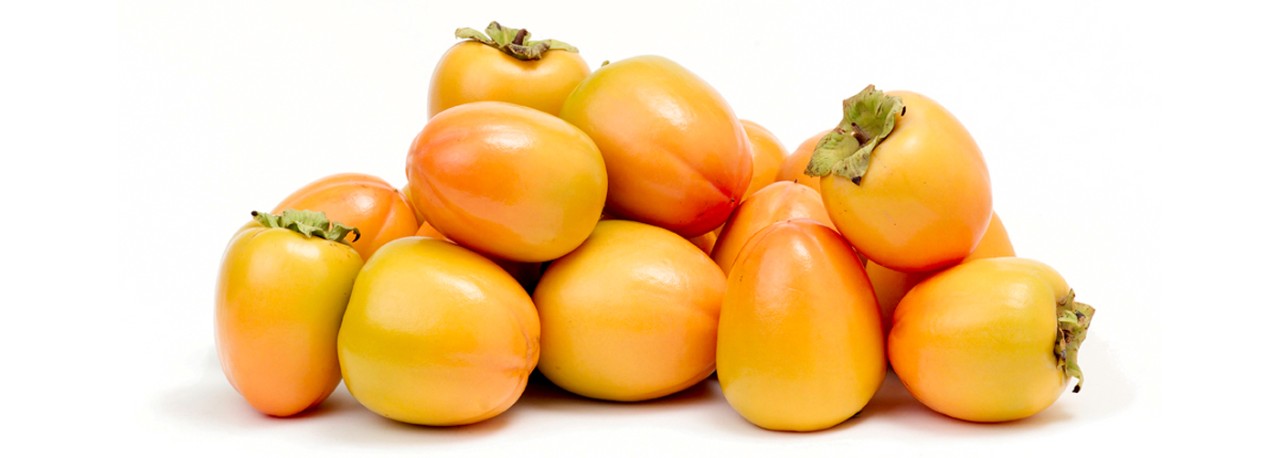.png.transform/rendition-xs/image_image%20(1).png)
Kaki Ribera del Xúquer PDO
Fruit of the persimmon or kaki (Diospyros kaki) of the Bright Red variety.
Tasting notes
Orangey-yellow when harvested but turns bright red as it ripens. The pulp is firm and reddish-orange when picked, then bright red when fully ripe. Its astringency when picked can be reduced to give a sweet flavor.
Other notes
This is a berry normally formed by parthenocarpy so, since pollination does not take place, the fruits have no seeds. Semi-adhesive, medium-thick skin. A transverse cross-section of the fruit is round, and a longitudinal cross-section slightly elongated. The fruits covered by the PDO must have a minimum diameter of 61 mm.
Production / Processing method
The variety used is the Bright Red which belongs to the Diospyros kaki species, the rootstock being Diospyros loto. Plant density is between 5x5 m. (16’5”x16’5”) and 5x4 m.(16’5”x 13’1”). Normally, grafted plantlets are used for planting in the fields. The trees are pruned in vase shape with 3-4 scaffold branches. It is essential to cut back and thin fruiting branches and to remove suckers and non-productive branches.
Tilling is usually limited to the control of accidental growth but in some cases ground cover should be retained. Water should be provided frequently to guarantee a good crop. The usual method of irrigation is by flooding.
Harvesting takes place between late September and early November when the fruit reaches the right degree of maturity. This is mostly determined by its color. The stem is cut in such a way that the calyx remains attached to the fruit. Picking, transport and handling must all be done with great care.
The picked fruits are first sent for preliminary storage, either in a chilled chamber or in a covered, well-aired place for the time needed to improve their color. Pre-selection then takes place, removing any fruits with shape or color defects, damaged skin, cracks, etc. They are then classified by size. Only top-quality fruits are covered by the PDO.
The fruits are then placed in commercial packs. The visible part of the contents must be representative of the rest and all the fruits must be of uniform quality and size.
Geography / Relief and climate
Many of the growing areas are located on the low plain along the banks of the rivers Júcar (Xúquer in Valencian) and Magro, where the soil is very compact and rich, with alluvium brought by the Júcar and its tributaries as they come down from the mountains. Also, on the lower parts of the valley, where the slopes are gentle, there are loose, colluvium soils with pink earth, which are very suitable for intensive farming.
On such land, frequent irrigation is needed to guarantee good plant yield. The soils are loamy-clay, deep and well-drained, as is typical of riparian soils, which are generally very rich and fertile. The usual watering method is by flood irrigation.
The local climate is mild and good for persimmon cultivation. The annual average temperature is 17º C (62.6º F), with averages of 9 - 10º C (50º F) in January and of 24 - 25º C (77º F) in August. There are few clouds, and rainfall is between 400 and 500 mm (15.7 - 19.6'') on average per year. Moreover, the surrounding mountains protect the crops against frost, especially in the tributary valleys.
These soil and climate characteristics in the growing area determine the quality and characteristics of the PDO fruits. The height-to-diameter ratio is higher and with greater peaks in warm, dry climates, helping set apart these fruits.
Regulatory Council
Consejo Regulador de la DOP Kaki Ribera del Xúquer
Plaça País Valenciá, 7
46250 L'Alcudia (Valencia)
Tel: (+34) 962 997 702
d.o.kaki@kakifruit.com
www.kakifruit.com/
Sources:
Many of the growing areas are located on the low plain along the banks of the rivers Júcar (Xúquer in Valencian) and Magro.


- /content/dam/en/icex-foodswines/images/products/fruits---vegetables/kaki-ribera-del-xúquer-pdo/Kaki%20Ribera%20del%20Xúquer%20PDO%20carr1.jpg
- /content/dam/en/icex-foodswines/images/products/fruits---vegetables/kaki-ribera-del-xúquer-pdo/Kaki%20Ribera%20del%20Xúquer%20PDO%20carr2.jpg

L'Alcudia (Valencian Community)
